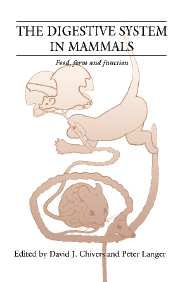Book contents
- Frontmatter
- Contents
- List of contributors
- Preface
- Part I Introduction
- 1 Gut form and function: variations and terminology
- 2 Food and digestion of Cenozoic mammals in Europe
- 3 Modelling gut function: an introduction
- 4 Optimum gut structure for specified diets
- Part II Food
- Part III Form
- Part IV Function
- Part V Synthesis and perspectives
- Index
4 - Optimum gut structure for specified diets
Published online by Cambridge University Press: 18 March 2010
- Frontmatter
- Contents
- List of contributors
- Preface
- Part I Introduction
- 1 Gut form and function: variations and terminology
- 2 Food and digestion of Cenozoic mammals in Europe
- 3 Modelling gut function: an introduction
- 4 Optimum gut structure for specified diets
- Part II Food
- Part III Form
- Part IV Function
- Part V Synthesis and perspectives
- Index
Summary
Mammals all have their guts built of the same units – oesophagus, stomach and small and large intestines – but there are many variants on the basic design (Stevens, 1988). Not only are carnivore guts very different from those of herbivores but there are marked differences between one herbivore and another. For example, cattle have huge, complex stomachs but horses have small stomachs and enormous large intestines. This paper tries to explain the differences by means of a mathematical model that predicts optimum gut structures for specified diets. The details of the model have been presented elsewhere (Alexander, 1991). We will be concerned principally with herbivores, because plant food presents particularly interesting problems to the animals that eat it.
Digestion and fermentation
The foodstuffs in plant cells, like those in animals, are easily digested by the enzymes of vertebrates, which break them down into compounds such as simple sugars and amino acids that are easily absorbed from the gut into the bloodstream. Plant cells, however, are enclosed in fibrous walls that consist largely of compounds that cannot be broken down by any of the enzymes that vertebrates produce. Some of these compounds (for example, lignin) are useless to herbivores, passing through their guts unchanged. Others (notably cellulose) are equally resistant to the herbivore's own enzymes, but may be broken down by microbes living in the herbivore's gut.
The microbes cannot oxidize the food because partial pressures of oxygen in the gut are very low. Instead, they ferment it, converting cellulose anaerobically to fatty acids, carbon dioxide and methane.
- Type
- Chapter
- Information
- The Digestive System in MammalsFood Form and Function, pp. 54 - 62Publisher: Cambridge University PressPrint publication year: 1994
- 8
- Cited by



